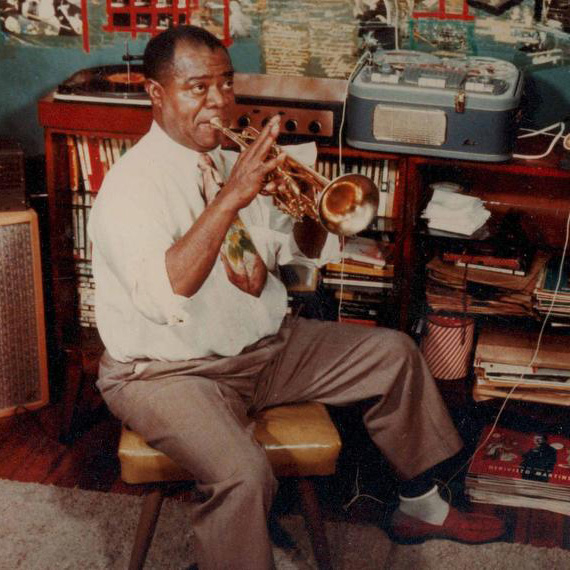Fans of Louis Armstrong can now hear their favourite musician practising, relaxing with friends and squabbling with his wife as if they were in his New York home 60 years ago.
A new digital exhibition from the Louis Armstrong House Museum in Queens is bringing rarely heard home recordings of Satchmo into the living rooms of jazz devotees worldwide.
The sound clips and photographs on the “That’s My Home” page of the museum’s website come from its digital collections, which include Louis and Lucille Armstrong’s trove of over 1,600 sound recordings, 650 home-recorded reel-to-reel tapes and 5,000 images.
They reveal his happiness, wit and creativity in the home that Lucille, a former Cotton Club dancer, bought for the couple after their marriage in 1942.
The curators’ commentary explains how, after years of living in hotels between tours, Armstrong was initially sceptical of the benefits of home-ownership, but came to love the $8,000 redbrick house at 34-56 107th Street, near Flushing Meadows, where he had a “den” for his practicing and hobbies.
Though he continued to travel for more than 300 days a year at the height of his fame, he relished the moments he spent at home.
“And take this neighbourhood we live in,” Armstrong told Ebony magazine in 1964, the year that he knocked the Beatles off the Billboard Hot 100 chart with Hello, Dolly!

“We’re right out here with the rest of the coloured folk and the Puerto Ricans and Italians and the Hebrew cats. We don’t need to move out in the suburbs to some big mansion with lots of servants and yardmen and things. What for? What the hell I care about living in a ‘fashionable’ neighbourhood? Ain’t nobody cutting off the lights and gas here ’cause we didn’t pay the bills. The Frigidaire is full of food, what more do we need? Pops, my motto is ‘Eat Good, Stay Healthy and Don’t Worry About Being Rich.’”
Armstrong recorded many of the goings on in the house, including practice sessions, conversations with friends and small talk with Lucille, on reel-to-reel tapes.
Sometimes this led to rows. In one example from the virtual exhibition, Lucille asks: “Now what the shit? You got that f***ing thing on? Hey! Turn your tape recorder off.”
“I’ve got thousands of tapes,” her husband drawls back, in his unmistakeable gravelled voice.
She responds: “I didn’t give a shit about your thousands of tapes … turn your tape off. In fact, erase some of that shit.” Both start chuckling.
“It’s for posterities,” Armstrong explains. “Posterity, my ass,” she retorts.
“We don’t need to move out in the suburbs to some big mansion with lots of servants and yardmen and things. What for?”
Many other recordings on the virtual-exhibition site showcase Armstrong’s musicianship and capture his trumpet warm-up and practice routines. This included playing along to records, whatever was on the radio, or simply improvising such as playing his own solo interpretation of Schubert’s Serenade.
In one sequence from 1953, Louis is heard warming up by himself before being interrupted by the start of The Guy Lombardo Show. Hearing the strains of Lombardo’s theme, Auld Lang Syne, Armstrong joins in. As Lombardo launches into Blue Belles of Scotland, Armstrong listens for a few seconds then blows along with the melody.
In another tape on the site, from February 1956, Louis can be heard recording an audio letter for the French jazz authority Hugues Panassié.

Ray Martino’s Stranger in Paradise can be heard in the background and Lucille interrupts to correct her husband when he gets the date wrong twice, prompting laughter.
The exhibition also features a two and half hour recording of a conversation between Armstrong and his friends, the music journalist Dan Morgenstern and photographer Jack Bradley, in 1965. Armstrong speaks about his recent tour behind the Iron Curtain. He recalled how, in East Germany, “some cats were saying, ‘Supposing they keep you over?’ And I said, ‘Well, as long as I can blow’.”
The interview, or “chops session” as Armstrong called it, was lubricated with a bottle of Slivovice damson brandy that Armstrong had brought back from Czechoslovakia, the effects of which are obvious as the session progresses.
Ricky Riccardi, the museum’s director of research collections, said more content would be added regularly.
“Visitors will be able to hear Louis practice, examine his collages, read his writings and basically feel like they are hanging out with Louis Armstrong in his den in Queens.”
The museum’s complete digital archive, the largest for a single jazz musician, can be browsed here.

